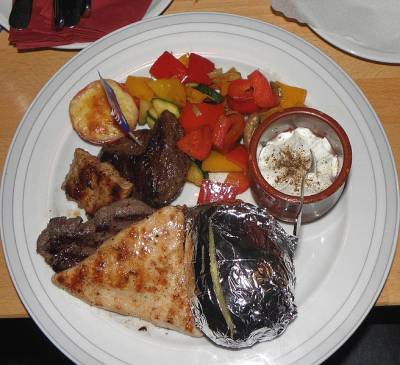 Food Safari takes you on a culinary globetrot across Australia. So in essence, with each episode you discover two cultures at the same time—Australia's and that of the featured culinary cuisine.
Food Safari takes you on a culinary globetrot across Australia. So in essence, with each episode you discover two cultures at the same time—Australia's and that of the featured culinary cuisine.
Maeve O’Meara is an award-winning television food presenter and author (Food Lovers' Guide to Australia, Better Homes and Gardens, SBS Eating Guides to Sydney and Melbourne). Maeve has spent the last 15 years exploring the many cuisines that make Australian culinary scene so vibrant.
Maeve has spent her life collecting recipes, from her early days baking with her grandmother to her in-depth exploration of the many cuisines around the world. Her expertise as food editor in major magazines, television food presenter and cookbook author—combined with a passion for food—make her an engaging and knowledgeable host.
The idea for the series came from Maeve’s food adventure business Gourmet Safaris and observing what people most want to know: the basics.
To delve deeper into the rich and colorful history, culture and people behind each cuisine, just click on the Show More  link—your "passport" to a fascinating new world of exotic sights, sounds, textures, aromas and flavors. We begin our safari with multicultural Australia.
link—your "passport" to a fascinating new world of exotic sights, sounds, textures, aromas and flavors. We begin our safari with multicultural Australia.
About Australia
Australia is a country in the Southern Hemisphere comprising the mainland of the Australian continent, the island of Tasmania and numerous smaller islands in the Indian and Pacific Oceans.
For at least 40,000 years before European settlement in the late 18th century, Australia was inhabited by indigenous Australians, who belonged to one or more of roughly 250 language groups. Indigenous Australians are distinguished as either Aboriginal or Torres Strait Islanders, who currently together make up more than 2.5% of Australia's population.
At the time of European settlement in the late 18th century, most Indigenous Australians were hunter-gatherers, and although their technical culture remained static—depending on wood, bone, and stone tools and weapons—their spiritual and social life was highly complex and based on reverence for the land and a belief in the Dreamtime. They established among the longest surviving artistic, musical and spiritual traditions known on earth.
After discovery by Dutch explorers in 1606, Australia's eastern half was claimed by Britain in 1770 and initially settled through penal transportation to the colony of New South Wales. Introduced disease and conflict with the British colonists greatly weakened Indigenous Australia throughout the period.
However, the colonial population continued to grow steadily in subsequent decades. The continent was explored, and gold rushes and agricultural industries brought prosperity. Autonomous Parliamentary democracies began to be established throughout the six British colonies from the mid-19th century. The colonies voted by referendum to unite in a Federation in 1901, and modern Australia came into being. Since Federation, Australia has maintained a stable liberal democratic political system and is a Commonwealth realm.
Australia fought on the side of Britain in the World Wars and became a long standing ally of the United States when threatened by Imperial Japan during World War II. Trade with Asia increased and a post-war multicultural immigration program received more than 6.5 million migrants from every continent. The population tripled in the six decades to around 22.8 million in 2010, with people originating from 200 countries.
Economy:
A developed country, Australia has a market economy with high GDP per capita and low rate of poverty. Australia is the world's thirteenth largest economy and has the ninth highest per capita GDP; higher than that of the United Kingdom, Germany, France, Canada, Japan, and the United States. Australia holds a position 16 in Global Competitiveness Index 2010–2011 rankings made by World Economic Forum. All of Australia's major cities fare well in global comparative liveability surveys; Melbourne reached second place on The Economist's 2008 World's Most Livable Cities list, followed by Perth, Adelaide, and Sydney in fourth, seventh and ninth place respectively.
Australia ranks highly in many international comparisons of national performance such as human development, quality of life, health care, life expectancy, public education, economic freedom and the protection of civil liberties and political rights. Nonetheless, Indigenous Australians experience higher than average rates of imprisonment and unemployment, lower levels of education, and life expectancies for males and females that are 11–17 years lower than the 79.7 years of non-indigenous Australians. Some remote Indigenous communities have been described as having "failed state"-like conditions.
Demographics:
Australia is the 50th most populous country in world. Sixty percent of Australia's population is concentrated and around mainland state capitals of Sydney, Melbourne, Brisbane, Perth and Adelaide. The nation's capital city is Canberra, in the Australian Capital Territory. Approximately 57% of Australia's population live in either Victoria or New South Wales, and 79% live in the eastern states of Australia.
In the 2006 Australian census, the most commonly nominated ancestry was Australian (37%), followed by English (32%), Irish (9%), Scottish (8%), Italian (4%), German (4%), Chinese (3%), and Greek (2%); 455,026 people (or 2.3% of the total Australian population) reported they were of Aboriginal and/or Torres Strait Islander origin.
Australia has no state religion. In the 2006 census, 64% of Australians listed themselves as Christian, including 26% as Roman Catholic and 19% as Anglican. About 19% of the population cited "No religion" (which includes humanism, atheism, agnosticism and rationalism). The largest non-Christian religion in Australia is Buddhism (2.1%), followed by Islam (1.7%), Hinduism (0.8%) and Judaism (0.5%). Overall, fewer than 6% of Australians identify with non-Christian religions. Weekly attendance at church services was about 1.5 million: about 7.5% of the population.
Culture:
Since 1788, the basis of Australian culture has been strongly influenced by Anglo-Celtic and Western culture. Distinctive cultural features have also arisen from Australia's natural environment and Indigenous cultures. Since the mid-20th century, American popular culture has strongly influenced Australia, particularly through television and cinema. Other cultural influences come from neighboring Asian countries, and through large-scale immigration from non-English-speaking nations.
Tourism:
Tourism in Australia is a large sector of the economy. In 2003/04, the tourism industry represented 3.9% of Australia's GDP. 5.7 million tourists visited Australia for the year ending April 2010. Japanese tourists make up a distinctive part of the Australian tourism market. Another major source of tourists to Australia include backpackers, mostly young people from Western European countries (particularly the United Kingdom) and North America.
The Great Barrier Reef attracts up to two million visitors every year. Careful management, which includes permits for camping and all commercial marine tourism within the Great Barrier Reef Marine Park, has so far insured that tourists have a very minimal impact on the reef
With a profusion of seaside resort towns in every state (many located on or near good surfing beaches), mountain retreats, plentiful national parks, rivers, fishing locations, wine growing regions and more, Australia offers something for every taste and budget.
Australian Cuisine
 Australian cuisine refers to the cuisine of the Commonwealth of Australia. Australia was, from 1788 to 1900, a collection of British colonies in which culinary tastes were strongly influenced by British and Irish cuisine—and agricultural products such as beef cattle, sheep and wheat became staples in the national diet.
Australian cuisine refers to the cuisine of the Commonwealth of Australia. Australia was, from 1788 to 1900, a collection of British colonies in which culinary tastes were strongly influenced by British and Irish cuisine—and agricultural products such as beef cattle, sheep and wheat became staples in the national diet.
Post-war Australia's multicultural immigration, with a majority drawn from South East Asian and the Mediterranean region, and the strong, sophisticated food cultures these ethnic communities have brought with them influenced the development of Australian cuisine.
Besides the culinary heritage of the Anglo-Celtic majority, the cuisines of China, Germany, Greece, Italy, Lebanon, Malaysia, Thailand, Vietnam are not only popular, but have also left the greatest impact on Modern Australian cuisine. In recent times there are also substantial influences and culinary trends from American cuisine, French cuisine, Indian cuisine, Japanese cuisine, Moroccan cuisine and Spanish cuisine.
Australian cuisine of the first decade of the 21st century shows the influence of globalization. Organic and biodynamic, kosher and halal foods have become widely available and there has been a revival of interest in bushfoods. British traditions persist to varying degrees in domestic cooking and the takeaway food sector, with roast dinners, the Australian meat pie and fish and chips remaining popular, but there are also new elements featured in these foods.
To barbecue meats in the open air is considered a treasured national tradition. Australia's climate makes barbecues commonplace. Barbecue stalls selling sausages and fried onion on white bread with tomato or barbecue sauce are common in fund raising for schools or community groups. These stalls are called "Sausage Sizzles".
While fast food chains are abundant, Australia's metropolitan centres possess many famed haute cuisine and nouvelle cuisine establishments. Restaurants whose product includes contemporary adaptations, interpretations or fusions of exotic influences are frequently termed "Modern Australian".
Seafood:
Australia's fishing zone is the third largest in the world and allows for bountiful access to seafood which significantly influences Australian cuisine. With most of the Australian population residing in coastal areas, fish and seafood is popular and they have ready access to high quality seafood restaurants and local fish and chip shops.
Clean ocean environments around Australia produce high quality seafoods for domestic consumption and export. Lobsters, prawn, tuna, salmon and abalone are the main ocean species harvested commercially, while aquaculture produces more than 60 species for consumption including edible oysters, salmonoids, southern bluefin tuna, mussels, prawns, barramundi, yellowtail kingfish, and freshwater finifish. While inland river and lake systems are relatively sparse, they nevertheless provide some unique fresh water game fish and crustacea suitable for dining. Approximately 600 varieties of marine and freshwater seafood species are caught and sold in Australia for both local and overseas consumption.
Fresh Produce:
 Fresh produce is readily available and thus used extensively, and the trend (urged by long-term government health initiatives) is towards low-salt, low-fat healthy cookery incorporating lean meat and lightly cooked, colorful, steamed or stir-fried vegetables. In the temperate regions of Australia vegetables are traditionally eaten seasonally, especially in regional areas, although in urban areas there is large scale importation of fresh produce sourced from around the world by supermarkets and wholesalers for grocery stores, to meet demands for year-round availability.
Fresh produce is readily available and thus used extensively, and the trend (urged by long-term government health initiatives) is towards low-salt, low-fat healthy cookery incorporating lean meat and lightly cooked, colorful, steamed or stir-fried vegetables. In the temperate regions of Australia vegetables are traditionally eaten seasonally, especially in regional areas, although in urban areas there is large scale importation of fresh produce sourced from around the world by supermarkets and wholesalers for grocery stores, to meet demands for year-round availability.
During Spring: artichoke, asparagus, beanshoots, beetroot, broccoli, cabbage, cauliflower, cucumber, leek, lettuce, mushrooms, peas, rhubarb, and spinach.
During Summer: capsicum, cucumber, eggplant, squash, tomato, and zucchini.
There are many species of Australian native fruits, such as Quandong (native peach), Wattleseed, Muntries/Munthari berry, Illawarra plums, Riberry, Native Raspberries and lilli pilli. These usually fall under the category of "bush tucker", (bush foods). Australia also has large fruit growing regions. The Granny Smith variety of apples first originated in Sydney, Australia in 1868.
Beverages:
The Australian Wine Industry is the fourth largest exporter of wine around the world. Wine is produced in every state, with more than 60 designated wine regions totaling approximately 160,000 hectares. Australia’s wine regions are mainly in the southern, cooler parts of the country, in South Australia, New South Wales, Victoria, and Western Australia. Amongst the most famous wine districts are the Hunter Valley and Barossa Valley and among the best known wine producers are Penfolds, Rosemount Estate, Wynns Coonawarra Estate and Lindeman's.
Beer in Australia has been popular since colonial times. Since the 1970s, Australian beers have become increasingly popular globally—with Fosters lager being an iconic export brand. Fosters is not however the biggest seller on the local market, with alternatives including Victoria Bitter outselling the popular export.
Australia has a distinct coffee culture and is often cited as being one of the most developed and vibrant in the world. The development of the coffee industry has grown not from coffee chains but through independent cafés born out of early Greek and Italian immigration since the early 20th century. The iconic Greek cafés of Sydney and Melbourne were the first to introduce locally roasted coffees in 1910. In 1952, the first espresso machines began to appear in Australia and a plethora of fine Italian coffee houses were emerging in Melbourne and Sydney. This decade also saw the establishment of one of Australia's most iconic coffee brands, Vittoria which remains the country's largest coffee maker and distributor. The Australian invented flat white was developed sometime in the latter half of the 20th century. It has become extremely popular across the country and is one of the most popular espresso beverages.
Although Australians often drink tea at home, it has been found that in out-of-home establishments where tea and coffee are sold together, tea accounted for only 2.5% of total sales.
Episodes:
 |
AFRICAN: Wherever you are in Africa, no meal is complete without a starchy porridge known as fufu. |
 |
BRAZILIAN: An exuberant, colorful mix of Portuguese, African and native foods including some from the Amazon. |
 |
CHINESE: Two thirds of households own a wok and use it regularly, but not everyone knows how to use it properly. |
 |
EGYPTIAN: Beans are used extensively and creatively as a source of protein, fibre, and comfort. |
 |
ENGLISH: "Meat & three veg" originated in the UK with dishes like roast beef, steak and kidney pie, and many more. |
 |
FRENCH: The French have elevated food into an art form. Nowhere else is so much attention paid to what people are going to eat and how. |
 |
HUNGARIAN: A fusion of simple peasant food & the elegant, highly developed cuisine from the days of the Austro Hungarian Empire. |
 |
INDIAN: A vibrant, intensely colorful cuisine. Each region of India has its own style of cooking and distinct flavors. |
 |
INDONESIAN: One of the most vibrant and colorful cuisines in the world, full of intense flavor and varied textures. |
 |
ITALIAN: An long-awaited introduction to the kitchens and restaurants of Australia’s top Italian chefs and home cooks. |
 |
JAPANESE: Refined and elegant, its preparation and presentation honed over the centuries so its flavors are pure and delicate. |
 |
JEWISH: While flavors of the Jewish palate are influenced by geography, the constant for Jews all over the world are the Kosher laws. |
 |
KOREAN: Some of the healthiest food on earth, with a near obsession with the fermented vegetable kimchi. |
 |
LEBANESE: Lebanese cuisine is generous and abundant, and this is some of the most exquisite food in the world. |
 |
MALTESE: The rocky island of Malta is home to some beautiful rustic recipes that sing of Mediterranean flavor and freshness. |
 |
MEXICAN: Authentic Mexican food is vibrant, spicy, delicious and fun. It varies according to which region its from. |
 |
MOROCCAN: One of the most cleverly balanced cuisines on earth; spices are used to enhance the flavor of dishes. |
 |
PAKISTANI: Full of marvelous and diverse dishes, it incorporates elements from its neighbors India, Afghanistan and Iran. |
 |
PERSIAN: From simple dips to hearty stews, food preparation is taken very seriously in Iran and is often a labor of love. |
 |
SOUTH AMERICAN: A fantastic fusion of culinary traditions from indigenous Indians, imported Africans, and the Spanish and Portuguese colonist. |
 |
SRI LANKAN: This beautiful spice island is a rich melting pot of every nationality that has visited and traded with it over the years. |
 |
SYRIAN: One of the highlights of Syrian food is mezza, a generous spread of small dishes and the prelude to even more food! |
 |
TURKISH: Nestled between Asia and Europe, Turkish food is an unique and exotic fusion with influences from many countries. |
Contact Us | Shop | Sitemap | Join Our Team | Investors | Advertise | Web Design Services
Community | Foodies' Choice | Meetup Groups | Chat | Blogs | Forums | Submit Your Site | Resources
